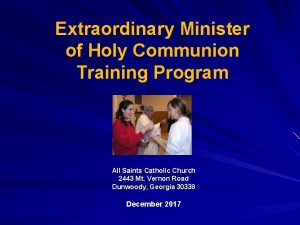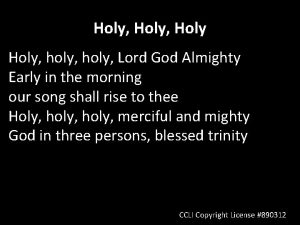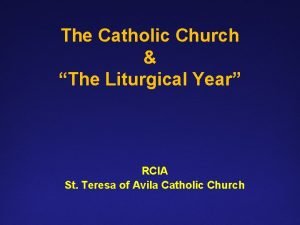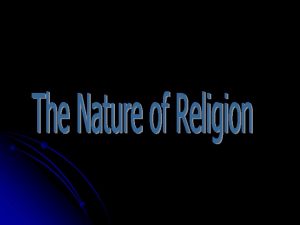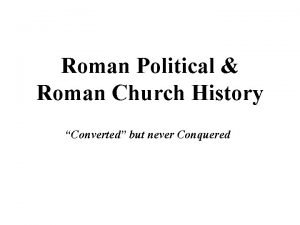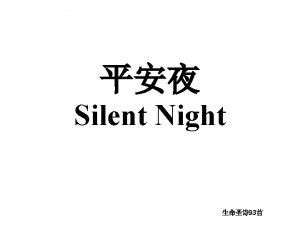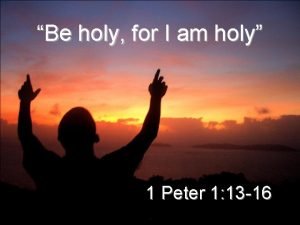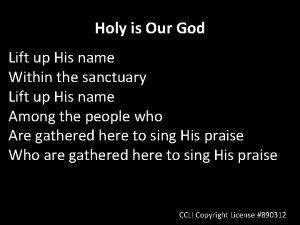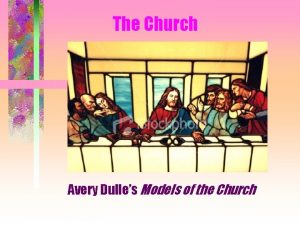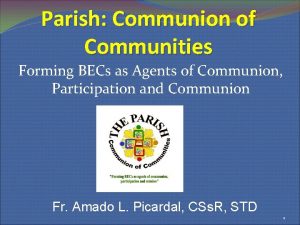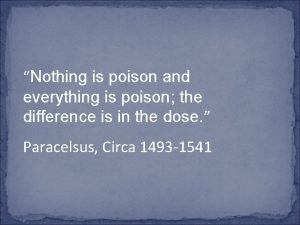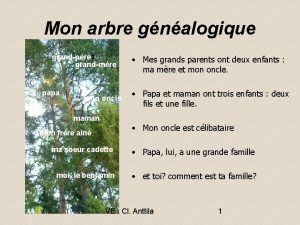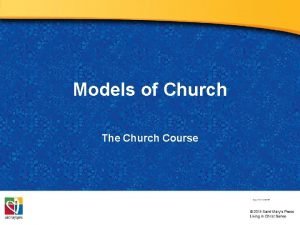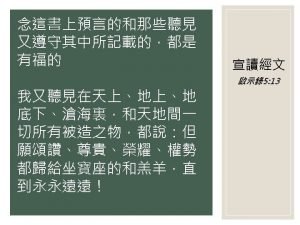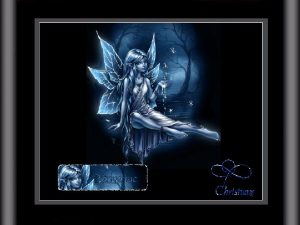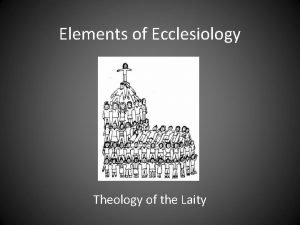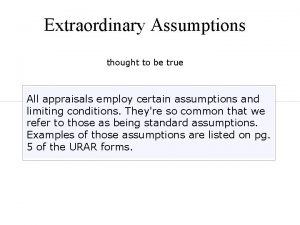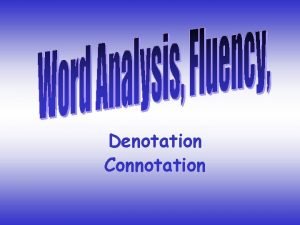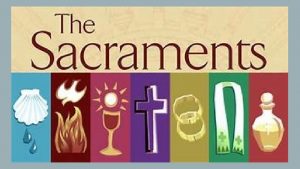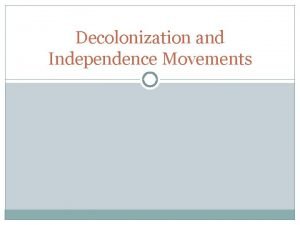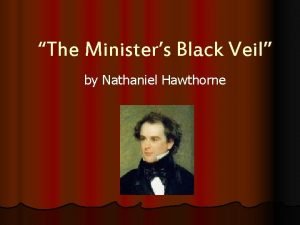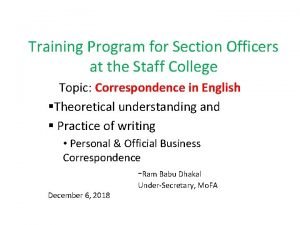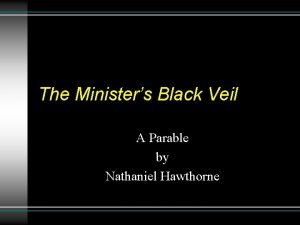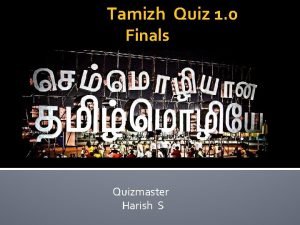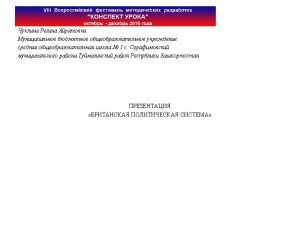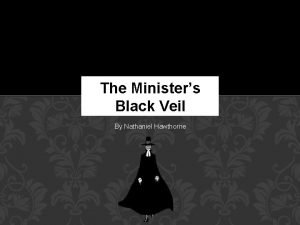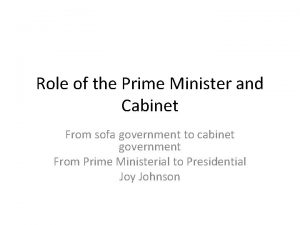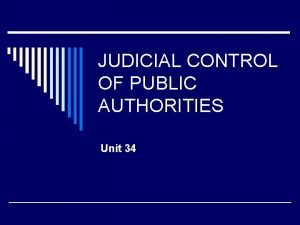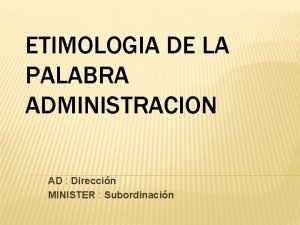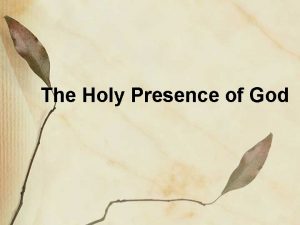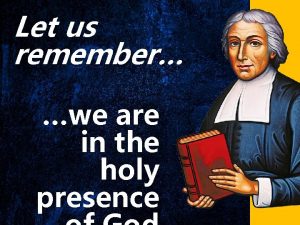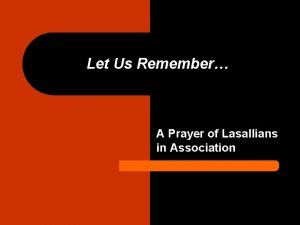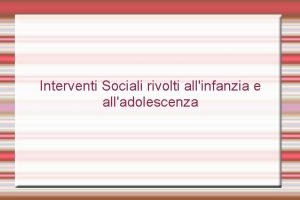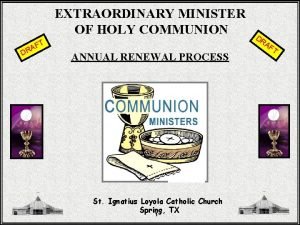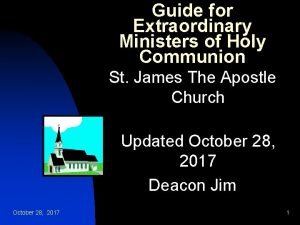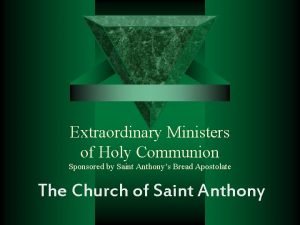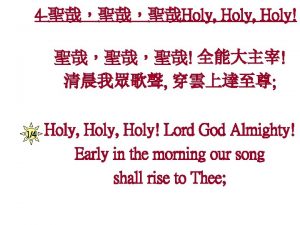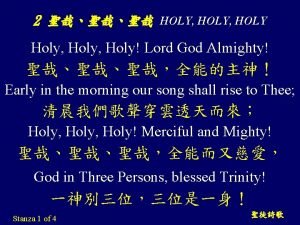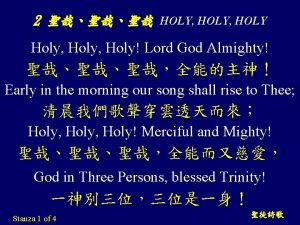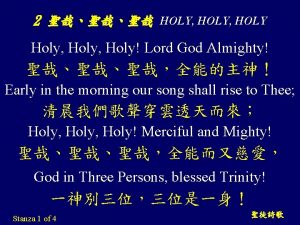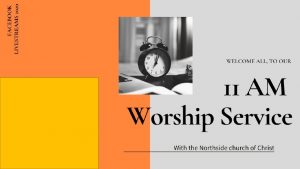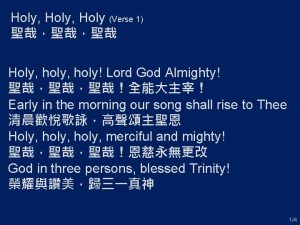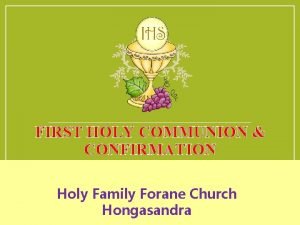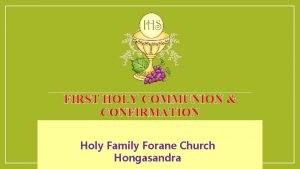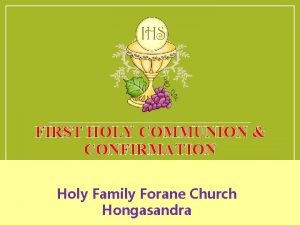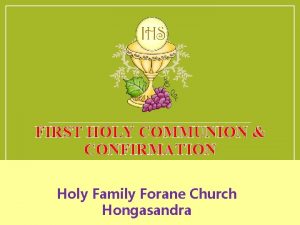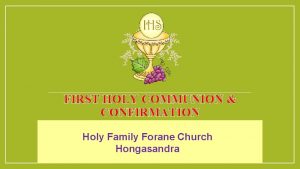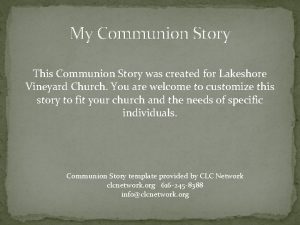Extraordinary Minister of Holy Communion Training Program All
































































- Slides: 64

Extraordinary Minister of Holy Communion Training Program All Saints Catholic Church 2443 Mt. Vernon Road Dunwoody, Georgia 30338 December 2017

Welcome and Prayer Jesus, bless these hands you have chosen as your tools. Jesus, always keep us aware and in awe of our sacred mission. Jesus, make us worthy of this great ministry we have humbly accepted. Jesus, send us out into the world to distribute your love.

Answers to Frequently Asked Questions Please read before proceeding The contents of this slide deck are taken directly from the EMHC training manual. If you have already studied the training manual, then you do not need to review these slides. This presentation was created for use during the in person training sessions, but you may find it helpful in reviewing the key points from the training manual.

Who are extraordinary ministers of Holy Communion? An EMHC is a lay person or religious who has been deputed by the bishop for a period of time, or by a priest or deacon for a single occasion, to assist the priest and deacon in distributing Holy Communion to the faithful on those occasions where a shortage of ordained clergy makes it impossible for them to distribute Holy Communion to all the faithful in a reasonable way. 1. It is an invitation, and privilege, not a right. 2. It is the exercise of a function that is proper to ordained priesthood, but due to necessity, must be carried out by others. 3. Proper term is Extraordinary Minister of Holy Communion.

Why does the Church regulate the liturgy? The Church … Is a communion with Christ, shared by believers throughout the world. Is not the property of any individual, priest, or local community, It belongs to the whole Church. To change it would isolate communities. Provides guidelines and regulations for universal Catholic worship. The regulations for EMHC should be understood with that spirit – not rules to be followed, .

When are extraordinary ministers called to serve? 1. At mass, when the presider is physically unable to distribute Communion. 2. At communion services when no ordained minister is available. 3. At masses where the great number of faithful prevents the priests and deacons from distributing Holy Communion to all of them. 4. To the sick when they are unable to be visited by a priest or deacon.

What are the qualifications to serve as an EMHC? Must be persons whose good qualities of Christian life, faith, and morals recommend them. Must be persons who show an example to the rest of the faithful by their own devotion and reverence toward the most august sacrament of the altar. The Archdiocese of Atlanta requires … 1. 2. 3. 4. 5. if married, be married within the Church have received the sacrament of Confirmation be at least 16 years of age have received the certification of properly qualified and trained completed the current safe environment and HIPP training (homebound)

How are extraordinary ministers selected? Extraordinary ministers are actively selected, not simply asked to volunteer. The goal is to choose individuals whose exemplary Catholic life and morals will reflect well upon the Church and show the dignity and importance of Holy Communion.

What follows the certification of an extraordinary minister? After they have been chosen…. EMHC should seek to cultivate holiness, through frequent confession, personal prayer, especially before the Blessed Sacrament, and attendance at daily mass if possible. EMHC should seek to have a good knowledge and appreciation for the thought and beliefs of the Church, especially through study of scripture and Church teaching. If an EMH finds it difficult to live a life appropriate to his function, he should recuse himself for a time from the distribution of Holy Communion, or, if necessary, a pastor might find it necessary to ask him not to continue his service.

What are the training requirements for an EMHC? View: 1. Serving as an Extraordinary Minister of Holy Communion 2. The Catholic Mass Revealed-Thy Kingdom Come (optional). Read: 1. “Rejoice in the Lord Always!” by Archbishop Donoghue’s. (Appendix 1) 2. The Real Presence of Jesus Christ in the Sacrament of the Eucharist: Basic Q&A. 3. All Saints Catholic Church Extraordinary Minister Training Manual Complete: 1. All Saints Catholic Church EMHC Application form (Appendix 4) 2. All Saints EMHC Self-Knowledge Assessment (Appendix 5) 3. Three shadow sessions a. at mass, in home, and in assisted living facility.

Training requirements continued… Attend: 1. All Saints Extraordinary Minister in person review session, annually. 2. All Saints Annual Commissioning Mass. 3. Archdioceses of Atlanta Safe Environment and HIPPA Training (EMHC for Homebound) Purchase: 1. Pyx, burse on a cord, and book titled Communion of the Sick. (EMHC for Homebound)

What is the correct terminology for the blessed sacrament? Although all of Christ is present under each species it is customary to refer to… the host after consecration as either simply “the host, ” or “the sacred body. ” the chalice may be referred to simply as “the chalice” or as “the precious blood. ” The terms “bread” and “wine” should be used to refer to the bread and wine brought forward as gifts, but not to the consecrated species, which are no longer bread or wine, but the body and blood of the Lord.

How long is an EMHC commissioned to serve? EMHC at All Saints Catholic Church are certified for 3 years. Our pastor is responsible for selecting the individuals designated to serve and for verifying that they are in good standing with the Church. A form is supplied to aid in this process (Appendix 5). After the individuals have been selected and trained, our pastor then submits a list to the Chancellor’s office. When they receive their certification, they are able to begin functioning as EMHC until their certification expires. Commissioning (and special blessing) will take place during all weekend masses on the second Sunday of January of each year.

How do I prepare to serve as an extraordinary minister? Remotely 1. As described above in the section entitled Way of Life of an EMHC Immediately before serving 1. Are in a state of grace 2. Having fasted 1 hour before mass 3. Take time in prayer before mass to prepare for service (ideally before the Blessed Sacrament chapel) Dress EMHC should dress in a way that is dignified and shows respect for the Blessed Sacrament and the function they are carrying out.

How are EMHC scheduled to serve? There is no formal scheduling for extraordinary ministers who serve during weekend masses. The exact number of ordinary ministers determines the number of extraordinary ministers needed. For most masses, 4 EMHCs are need when 1 species if offered and 11 EMHC are needed when both species are offered. Note: there is formal scheduling for EMHC who serve the homebound.

What do I do before mass? Arrive 20 minutes early and sign EMHC Sign-in Book. First come, first serve. EMHC should assume the role and sign-up without hesitation. EMHC #1 is team leader. Ushers will review the book 5 minutes prior to the start of mass and inform lector if additional EMHC are need. EMHC already seated, but not signed up should immediately proceed to the narthex and sign-in. The intent is to prevent the need for the usher to signal the need for extraordinary ministers during the Liturgy of the Eucharist. Once all crosses associated with a given mass have been removed, no more EMHCs is needed for that mass. Once mass begins and the number of ordinary ministers is apparent, the number of EMHCs may need to be increased or decreased.

Where do EMHC site during mass? During the mass, the extraordinary minister sits with their family and the rest of the faithful, and should participate fully in the mass, listening to the readings, and joining the community in prayer. If possible, extraordinary ministers should sit in the front pews and close to the aisle as a way to easily move to position prior to approaching the altar.

When and how do I approach the Altar? EMHC line up in two lines (hands in prayer formation) in front of the altar (just after the offering of peace and before the Lamb of God). Do not approach the altar until after all of the priests AND deacons have received both species of communion. At the appropriate time, the EMHC reverence the altar with a profound bow (30 degree bending of the torso) and walk to their position behind the altar. Do not wait to be called to approach the altar. The path taken should be around the outer edge of the sanctuary and stepup to the sanctuary from behind the ambo (left side) and lectern (right side) of the altar. Sanitize hands and then stand shoulder-to-shoulder behind altar facing the congregation.

How do I receive Holy Communion? Remain standing in a line standing shoulder-to-shoulder. The priest will distribute Holy Communion by starting on his left (EMHC position #1) while facing the line of 4 or (in the absence of a deacon) 5 extraordinary ministers. Receiving a Vessel when 1 Species is Offered Once the priest finish distributing the sacred body, the priest (and deacon) will hand a ciboria to each of the extraordinary ministers. The priest will begin at the right of the line (position 3 and 4) while the deacon will begin from the left of the line (position 1 and 2). Once all of the extraordinary ministers have received a ciboria (along with the priest and deacon), they should move in unison to their position around the edge of the sanctuary (figure 1). Extraordinary ministers should know where their station is before mass. Extraordinary ministers should only step down off the sanctuary (to distribute Holy Communion) if the priest steps down to administer Holy Communion. The figures below illustrate the locations where priests, deacons, and extraordinary ministers should stand to distribute Holy Communion when 1 species is offered.

How do I receiving a vessel when 1 species is offered? Once the priest and deacon finish distributing the sacred body and precious blood, the priest will begin handing a ciboria or cup to each EMHC. The priest will begin at the left of the line (EM position #1) while the deacon will begin from the right of the line. When both species are offered, the first 3 EMs and the last 3 EMs (in line) will be handed a ciboria, and the remaining 5 EMs (in the center of the line) will be handed a cup. EMs should always to be handed the vessel containing the Sacred Body or Precious Blood from the priest celebrant. Once all of the EMHC have received a ciboria or cup, they (along with the priest and deacon) move in unison to their position around the edge of the sanctuary. EMHC should know where their station is before mass (see figure 1 and 2 below). EMs should only step down off the sanctuary (to distribute Holy Communion) if the priest steps down to administer Holy Communion. The figures below illustrate the locations where priests, deacons, and EMHC should stand to distribute HC.

Where do I stand when 1 species is offered?

What are the procedures for distributing HC to those seated? Upon request by the usher, and after finishing the distribution of communion at their assigned location on the altar, the extraordinary minister assigned to position 1* will be escorted by the altar server holding a candle to the back of church and administer communion those unable to approach the altar. The server who rang the bells is the one responsible for escorting the extraordinary minister. The path taken is by exiting the sanctuary at aisle A and proceeding to the back of church and then around the back to the center aisle. Upon arrival to the back of church, an usher will identify individuals who requested communion while seated. The return path for the altar server and extraordinary minister is down the center aisle (D), reverence the altar (simple bow), then onto the sanctuary from behind the ambo.

Key reminders for masses where 1 species is offered When only 1 priest is celebrating mass and there is no deacon present, then a 5 th extraordinary minister is needed. The extraordinary minister in position 5 assumes the location normally occupied by the deacon to distribute communion. When 1 species is distributed AND 2 priest are celebrating the mass, the deacon moves to position 2*, and extraordinary minister assigned to position 2 remains seated in the pew. Every effort should be made prior to mass to make the necessary adjustments to the number of EMHC needed based on the number of ordinary ministers celebrating the mass. During the Sunday 5: 00 pm mass, it is necessary (due to the Lifeteen band) that EMHC assigned to position 3 step down from the sanctuary and stand in front of the first row of pews. It is never appropriate for an extraordinary minster to obtain hosts from the tabernacle.

How do I receive the vessel when 2 species are offered? Extraordinary ministers should remain in a line standing shoulder-to-shoulder to receive Holy Communion. The priest will distribute Holy Communion by starting on his left (EMHC position #1) while facing the line of 11 extraordinary ministers. When both species are offered (e. g. Sunday 10: 30 am mass), then the deacon will follow the priest and offer the precious blood to the extraordinary ministers.

Which EMHS receive the Precious Blood to distribute? Receiving a Vessel when 2 Species are Offered Once the priest and deacon finish distributing the sacred body and precious blood, the priest and deacon will hand a ciboria or cup to each of the extraordinary ministers. The priest will begin at the left of the line (EMHC position 1) and hand a ciboria to extraordinary ministers in positions 1, 2, and 3, and a cup to those in position 4 and 5. The deacon will begin from the right of the line (EMHC position 11) and hand a cup to the extraordinary ministers in position 6, 7, and 8, and a ciboria to those in position 9, 10, and 11.

Where do I stand when 2 species is offered? The priest will obtain the pyx containing gluten-free host from the altar, extraordinary should not obtain this pyx from the altar. Once all of the extraordinary ministers have received a ciboria, they will all move together-in unison with the priest and deacon-to their assigned position around the edge of the sanctuary (figure 2). Extraordinary ministers should know where their station is before mass. Extraordinary ministers should only step down off the sanctuary (to distribute Holy Communion) if the priest steps down to administer Holy Communion.

Where do I stand when 2 species are offered?

What are the procedures for distributing HC to those seated? During the Sunday 10: 30 am mass, an extraordinary minister will always go to the back of church to distribute communion. As all the extraordinary ministers begin to walk to their position on the altar, the extraordinary minister in position 1 will be immediately be escorted by an altar server bearing a candle, to (and from) the back of church. The server who rang the bells is the one responsible for escorting the extraordinary minister. The path taken is by exiting the sanctuary at aisle A and proceeding to the back of church and then around the back to the center aisle. Upon arrival to the back of church, the extraordinary minister should stand between the last two pews and administer communion to those seated in the cry room and standing in the back of church. Prior to returning to the altar, the usher will direct the extraordinary minister to individuals who requested communion while seated. The return path for the altar server and extraordinary minister is down the center aisle (D), reverence the altar (simple bow), then onto the sanctuary from behind the ambo.

Key reminders for when 2 species are offered When both species are distributed and only 1 priest is celebrating mass, and the deacon is absent, then a 12 th extraordinary minister is needed. The extraordinary minister in position 5 assumes the location normally occupied by the deacon to distribute the precious blood. When both species are distributed AND 2 priest are celebrating mass, the extraordinary ministers assigned to 9 H remains seated in the pew. Every effort should be made prior to mass to make the necessary adjustments to the number of EMHC needed based on the number of ordinary ministers celebrating the mass. The priest will obtain the pyx containing gluten-free host from the altar, extraordinary should not obtain this pyx from the altar. The precious blood should never leave the altar. Do not take the cup to those seated in the pews. Communicants must approach the altar to receive the precious blood. It is never appropriate for an extraordinary minster to obtain the scared body from the tabernacle.

Holy Days 4 EMHC for all except Holy Saturday where 11 EMHC are needed The Feast of Mary, the Mother of God (January 1) Ascension Thursday (40 days after Easter) Ash Wednesday (date varies) Assumption of the Blessed Virgin Mary (Aug 15) Holy Thursday (date varies) All Saints Day (November 1) Good Friday (date varies Feast of the Immaculate Conception (December 8) Holy Saturday Vigil (date varies)** Christmas (December 25)

How is Holy Communion to be distributed and received? The norm remains under one species and on the tongue, specific permissions have allowed communion under both species and communion on the hand to take place. On the tongue Communicant bows, and then approach the minister standing. Communion is not denied to those who approach by kneeling. The extraordinary minister takes the host and shows it to the communicant, saying “The Body of Christ. ” Other words are not appropriate. Take the host between the thumb and the forefinger and place the host on the tongue by pressing down with the forefinger from above (to avoid contact with the tongue). Prevent small fragments of the host from falling to the ground. Keep the host over the ciborium when possible.

How is Holy Communion to be distributed and received in hand? Communion in the Hand Observe the person receiving communion until he consumes the host. If they begin to walk off without receiving communion, it is important to follow that individual and either ask him to consume the host, or to retrieve it so that nothing untoward happens. Note: the decision to receive communion on the hand is on the part of the communicant, and no one can compel them to receive on the hand or on the tongue.

How is the precious blood to be distributed and received? Both Species In Archdioceses of Atlanta communion under both species is permitted at all massed, meaning individual priest celebrant decides to offer under 1 or both species. If communion is offered under both species, the ordinary minister of the chalice is the deacon; however, EMHC are permitted if needed. Only the words “The Blood of Christ” are acceptable. 1. Avoid any danger of spillage. 2. Make sure communicant takes chalice firmly before releasing it, 3. Do not hold on to the chalice while an individual receives communion. 4. Take the chalice, wipe the lip of it with the purificator, and rotate it slightly. 5. The decision to receive the precious blood from the chalice or not belongs to the individual communicant.

May a communicant receive the precious blood only? Communion from the Chalice Alone Some individuals, for medical reasons, are unable to receive even a small particle of the Sacred Host. For this reason, it is permitted for individuals to receive Holy Communion only under the species (appearance) of wine. ”In such cases, communion from the chalice is distributed just as when the communicant receives under both species. Precious blood is to only be consumed at the altar – not taken to pews.

Is a communion-Plate used? Some parishes in the Archdiocese of Atlanta have the custom of using communion-plates, which are held under the host as the communicant receives, usually by an altar server. This practice is recommended to avoid the danger of the sacred host or some fragment of it falling. When these plates are used, they are purified in the same way as the other sacred vessels. At this time All Saints does not use the communion-plates.

May a communicate instinct the scared body? Intinction Although it is not customary in the Archdiocese of Atlanta, the Church also permits communion under both species by Intinction. This decision is to be made by the priest celebrant–individual members of the faithful cannot chose to receive communion by Intinction when it is not offered. At All Saints Catholic Church, “The communicant must not be permitted to intinct the host himself in the chalice, nor to receive the intincted host in the hand. ”

Why do some communicants choose not to receive Holy Communion? Some people are unable (or choose not ) to receive Holy Communion 1. They have not yet made their first communion 2. Are not prepared through fasting 3. Are not in communion with the Catholic Church 4. Are in a state of serious sin 5. Other valid personal reasons Do not judge the motivation for an individual not receiving Holy Communion

May an EMHC offer a special blessing to a communicant? Although they are not a part of the approved rite of the mass, it has become customary in many parts of the United States for individuals who are not receiving Holy Communion to come forward and ask for a blessing. Often this is indicated by hands crossed across the chest… 1. Raise hand (without host) and respond with “Receive the Lord Jesus into your heart” or “May God Bless you” while raising hand 2. On rare occasions it may be appropriate to touch the individual, when doing so, do not touch the person with the fingers used for distributing Communion

May an EMHC deny Holy Communion? There are practically no situations when Holy Communion should be denied by an extraordinary minister. “Any baptized Catholic who is not prevented by law must be admitted to Holy Communion”. The EMHC should not make a judgment on the worthiness of any individual to receive Holy Communion. If the EMHC is unsure if an individual is Catholic or has received their first communion, then he should ask them or their parent, and if they reply that they are not, the EMHC should let them return to their pew without receiving communion.

What are the appropriate procedures for returning the blessed sacrament to the altar? 1. Do not set the ciborium or cup on the altar unless priest/deacon is not there. 2. If placed on the altar, be sure to place it on the corporal. 3. Do not stuff the purificator into the cup: lay it across the top of the cup. 4. Consume whatever remains of the precious blood before returning to the altar. 5. Return to altar and hand vessel to the priest or deacon. 6. Purify fingers using bowl of water at the credence table. 7. Proceed to the left side of the altar and wait. 8. Perform a profound bow when the priest kneels before the tabernacle. 9. Return to their pew once the priest stands.

What should an EMHC do if there is an accident involving either species? If a particle of the host falls on the ground, it should be picked up and consumed. If for some reason it cannot be consumed (for example, if it has already been in an individual’s mouth who is unable to consume it), it may be dissolved in water and the water later poured down the sacrarium. If some of the precious blood should fall to the ground. 1. ensure that no one steps on the spot by delegating an individual to guard it. 2. use a clean purificator to mark the spot. 3. with deacon’s assistance), pour water over the spot. 4. dilute with water to the point where it loses the appearance of wine 5. use a purificator to soak up water and place in lavabo bowl 6. pour water from lavabo bowl down the sacrarium. 7. precious blood dropped on an individual’s clothing or possessions should be treated in the same way, with respect for individual.

How are vessels to be purified? Purification of vessels should be done by a priest, deacon. Purification can take place on the altar or at the credence table, but not in the sacristy; this is not simply “doing the dishes” but a part of the ritual of the mass with respect to Christ. EMHC may assist in any cleaning or washing vessels after purification is complete. All of the Blessed Sacrament must be consumed, and that none of it may be disposed of in any way. The Church excommunicates anyone who disposes of the Blessed Sacrament (for example, by pouring the Precious Blood down the sacrarium. ) This excommunication can only be lifted by the Holy See.

How are altar linens cleaned? The individuals, who clean altar linens, in particular purificators, need to act with respect for the Blessed Sacrament. It is customary to soak all of the linens in water, so that any particles of the host or precious blood might be dissolved, and then pour this water down the sacrarium. It is not necessary to consume this water. After this process, they may then be washed normally, apart from other linens.

What are the procedures for service to the Sick and Homebound? EMHC should purchase this resource

How do EMHC for the homebound receiving the Blessed Sacrament? Upon arriving to mass, the EMHC for the homebound should take their pyx to the sacristy and fill it with the number of hosts needed. The EMHC should obtain a purificator from the sacristy (for use in purifying the pyx after use). Place their pyx on the credence table (on a tray) and be seated. After communion (Sunday 8: 45 am mass), EMHCs will be called to the altar and deacon hands pyx to EMHC. Place pyx in a burse on a cord and placed around the neck, or a shirt pocket. The burse and pyx should not be placed in a purse, pants pocket, or other location. EMHC should purchase pyx and burse with cord.

What are appropriate procedures for traveling with Holy Communion? Once the EMHC receives the Blessed Sacrament, it is important to go directly to the place where he is to distribute Holy Communion. It is never appropriate to take the Blessed Sacrament home for later distribution. These are considered grave matters by the Church. While on the way to distribute Holy Communion, it is important that the EMHC avoid anything that might diminish his focus on the Blessed Sacrament, for example, engaging in unnecessary conversations or listening to the radio in the car.

What are procedures for distributing Communion to the Homebound? Upon arrival the EMHC should move directly into the rite, as they are in the presence of the Blessed Sacrament. Postpone socializing. If they are met at the door with a candle for the Blessed Sacrament, they should be escorted to the place where they will distribute communion. If a table has been prepared with a white cloth and a crucifix, they should place the pyx on the table and genuflect in adoration. Follow the rite given for the distribution of Holy Communion in all cases. Purify the pyx (using the purificator) in the usual way. Leave behind a copy of the weekly church bulletin and a current Missalette. Return purificators to laundry basket located in the sacristy.

How is Holy Communion distributed during home visits? Home visits Conduct the Communion service according to pages 23 -28. As a minimum, begin with a prayer, followed by the reading of the day, end with a closing prayer. Adjust as needed. After giving the Eucharist, dab your fingers on your tongue or wipe them on the purificator, and neatly fold the purificator back to its original form to contain any fragments of the host. After the visit, follow the instructions below.

How is Holy Communion distributed at nursing homes? Nursing home visits Upon arriving, sign visitors’ log, wear cross and nursing home volunteer badge. Visit the Activities Office to learn procedures. Greet resident and identify yourself and ask if he/she would like to receive the Eucharist. If t no, ask if you may say a short prayer such as the Lord’s Prayer with them instead. Break hosts in half if needed. Refer to notes for additional details.

How do EMHC conduct a Communion Service? When conditions call for Sunday celebrations in the absence of a priest. EMHC should perform communion service in accordance to the guidelines outlined in Communion of the Sick (pages 9 -20 and Appendix 5). See details in note field of this slide.

Which Catholics may receive Holy Communion? Catholics 1. encouraged to receive Communion devoutly and frequently. 2. should not be conscious of grave sin except for a grave reason where there is no opportunity for confession. In this case, the person is to be mindful of the obligation to make an act of perfect contrition, including the intention of confessing as soon as possible. 3. normally have fasted for one hour. 4. a frequent reception of the Sacrament of Penance is encouraged for all.

Which fellow Christians may receive Holy Communion? For our fellow Christians We welcome all Christians to celebrate the Eucharist as brothers and sisters. Because Catholics believe that the celebration of the Eucharist is a sign of the reality of the oneness of faith, life, and worship, members of those churches with whom we are not yet fully united are ordinarily not admitted to Holy Communion.

Council for EMHC Program Goals 1. To provide support for the priest, and deacons during all masses, 2. To provide appropriate training for all EMHCs, and 3. To extend the presence of Christ to those who are unable to participate in the celebration of the Eucharist at the altar. Council Members 1. Chaplain 2. Scheduling Coordinator 3. Training Coordinator

Annual Calendar of Events Activity Date Bulletin/Pulpit Announcement: for new EMHCs and training dates Last 3 weekends of September Three training dates offered: new & existing EMHC to attend 1 of 3 Last 3 weeks of October Commissioning/special blessing of all (new and existing All Masses on 2 nd weekend of EMHCs) Nov. Update master list of active and inactive EMHCs Last two weeks of November Distribute certificates and inform Arch Dioceses of active EMHC December /January Additional training and commission available based on interest and need.

Scheduling There is no formal scheduling for extraordinary ministers who serve during weekend masses. The scheduling coordinator is responsible for identifying EMHCs to take the Holy Communion to the homebound. 1. The intent is to limit the number of site visits to 2 locations per EMHC. 2. Since the relationship between the EMHC and the homebound is very personal, efforts are made to minimize the variation in which EMHC visits any given locations. 3. A list of EMHC interested in participating in taking Holy Communion to the homebound will be maintained and opportunities to serve will expand over time so that long-term relationships can be established.

Glossary Ablution cup Cruets Paten Altar Evangeliary Precious Blood Ambo EMHC Purificator Blessed Sacrament Communion Host Pyx Burse Instituted Acolyte Ritual Books Ciborium/ (Pl) / Ciboria Lavabo Bowl and Pitcher Roman Missal Chalice Lectionary Sacrarium Chalice Veil Luna Sacred Vessels Communion-Plate Monstrance Sacristy Corporal Ordinary Minister of HC Sanctuary Credence Table Pall Sanctuary Lamp See definitions of terms in notes field

The Catholic Mass Revealed Segments of the Mass 1. Before Mass Duties 15. The Preparation of the Gifts 2. Entrance Processional 16. The Eucharistic Prayer 3. The Greeting 17. Holy, Holy 4. The Penitential Rite 18. Invocation/Consecration 5. The Kyrie Eleison 19. In Memory Offerings 6. The Gloria 20. Intercession 7. The Opening Prayer 21. Great Amen 8. The Liturgy of the Word 22. The Lord’s Prayer 9. The Alleluia 23. Sign of Peace 10. The Gloria 24. Lamb of God 11. The Homily 25. Holy Communion 12. The Profession of Faith 26. Concluding Rites 13. The Prayer of the Faithful 27. Recessional 14. The Offertory 28. After Mass Duties

True or False 1. EMHC exist because of the priest and deacon shortage. 2. EMHC have existed for centuries in the Catholic Church. 3. Serving as an EMHC is a right for anyone who is catholic. 4. The proper term to refer to an EMHC is Extraordinary Minister of Holy Communion. 5. The church regulates EMHCs to express universal catholic worship across the world. 6. EMHC may be called for extended (or single) periods of service. 7. There are 4 basic occasions when the church calls upon EMHCs to distribute HC. 8. Any parishioner may serve as a EMHCs. 9. I have watched the video, and read the training manual. 10. EMHC should recuse himself from serving if he is in a state of grave sin.

True or False 11. All EMHC at All Saints must attend one training class each calendar year. 12. The correct terminology is sacred body, and the precious blood. 13. EMHC must be certificated and have a certificate in hand prior to serving. 14. EMHC are only commissioned for 2 years. 15. EMHC should sign-in before ALL masses ti indicate their intent to serve. 16. EMHC should arrive at church early to obtain a cross and pray before the BS. 17. EMHC must sit in the front row of the church. 18. EMHC should only approach the altar just before the priest has receives communion. 19. Two lines of EMHC are formed on altar when receiving the ciborium/cup from priest. 20. The appropriate words EMHC use when distributing HC are “The Body of Christ”.

True or False 21. EMHC may not place the sacred body on the tongue of the communicant. 22. Both species distributed by EMHCs at all masses. 23. EMHC may distribute only the precious blood if requested by a communicant. 24. Communicants are permitted to intinct the host himself. 25. EMHC may use good judgment to determine who is worthy of receiving HC. 26. EMHC may offer special blessings to communicants. 27. There are only 3 situations where a EMHCs may deny HC to a communicant. 28. EMHC should always place the ciborium on the altar when finished distributing HC. 29. EMHC should stuff the purificator in the cup when finished distributing precious blood. 30. EMHC may pour excess precious blood down the sacrarium.

True or False 31. EMHC may purify a chalice and ciborium while at the altar. 32. Linens used during communion are soaked in water-which is poured down the sink. 33. EMHC who take communion to the homebound must learn the Rites of Communion. 34. EMHC may store the sacred body at home for 2 days prior to taking to homebound. 35. EMHC should leave behind a copy of the bulletin & missalette with homebound. 36. EMHC may perform a communion service in the absence of a priest. 37. Catholic should fast 1 hour prior to receiving HC (15 min for homebound). 38. Cannon law does not object to reception of HC by members of Orthodox churches. 39. Non-Christians are welcome to receive Holy Communion. 40. EMHC (homebound) are required to complete Safe Environment Training.

Procedure to Request Certification Contact Parish Office

Questions Called to Serve December 2017 Thank you for your service!!!

Closing Prayer Heavenly Father, I thank you for calling me to serve You and Your people in this community as an extraordinary minister of the Eucharist. You know that I could never be worthy of such an exalted honor. Help me to be less unworthy by remaining free of sin. Let me nourish Your people with the witness of my life as I feed them with the Body of Christ. Grant Your strength and holiness to all Your extraordinary ministers and make them worthy to bring Christ to others. Amen
 Extraordinary ministers of holy communion training
Extraordinary ministers of holy communion training Holy holy god almighty the great i am
Holy holy god almighty the great i am Holy holy god almighty there is none like you
Holy holy god almighty there is none like you Commune with the holy spirit
Commune with the holy spirit Communion 000yearold holy
Communion 000yearold holy .#
.# Beyond politics communion 000yearold holy mystery
Beyond politics communion 000yearold holy mystery Silent night holy night all is calm
Silent night holy night all is calm Holy ghost vs holy spirit
Holy ghost vs holy spirit Be holy as i am holy
Be holy as i am holy Lift up his name
Lift up his name Holy holy hol
Holy holy hol Deuteronomy 20:8
Deuteronomy 20:8 Opposite rays
Opposite rays Salvation army communion
Salvation army communion Dulles models of the church
Dulles models of the church Communion of communities
Communion of communities Everything is poison
Everything is poison Carte de félicitation première communion
Carte de félicitation première communion Church structure models
Church structure models Communion stanislavski
Communion stanislavski Communion bible verses
Communion bible verses Communion solennelle autrefois
Communion solennelle autrefois Communion elements
Communion elements Traditional anglican communion
Traditional anglican communion Communion rite parts
Communion rite parts The most extraordinary country to explore
The most extraordinary country to explore Extraordinary life quotes
Extraordinary life quotes 4 obsessions of an extraordinary executive summary
4 obsessions of an extraordinary executive summary Hypothetical vs extraordinary assumption
Hypothetical vs extraordinary assumption Personal growth definition
Personal growth definition Word study denotation and connotation
Word study denotation and connotation The extraordinary properties of water
The extraordinary properties of water The extraordinary properties of water
The extraordinary properties of water Neutral denotation
Neutral denotation Characteristics of extraordinary teachers
Characteristics of extraordinary teachers Form of penance
Form of penance Gatsby chapter 9 summary
Gatsby chapter 9 summary What are the six ministerial priorities?
What are the six ministerial priorities? Who was the first prime minister of india
Who was the first prime minister of india Optionale istorie aprobate de minister
Optionale istorie aprobate de minister What does the black veil symbolize
What does the black veil symbolize Much to everyone's dislike the outspoken
Much to everyone's dislike the outspoken Chief minister special cell in tamil
Chief minister special cell in tamil Sample letter to minister of foreign affairs
Sample letter to minister of foreign affairs The minister's black veil drawing
The minister's black veil drawing Karnataka chief minister bs yediyurappa
Karnataka chief minister bs yediyurappa Prime minister of afghanistan
Prime minister of afghanistan Monarchy system
Monarchy system The minister's black veil symbolism
The minister's black veil symbolism 10 roles of a prime minister
10 roles of a prime minister Allingham v minister of agriculture and fisheries
Allingham v minister of agriculture and fisheries Diaconal ministry
Diaconal ministry Minister zdravotníctva zajac
Minister zdravotníctva zajac Etimologia de administracion
Etimologia de administracion Let us remember that we are in the holy presence of god
Let us remember that we are in the holy presence of god Maestra lidia greetings
Maestra lidia greetings Www.lasalle-ialu.org
Www.lasalle-ialu.org Let us remember that we are in the holy presence of god
Let us remember that we are in the holy presence of god Training is expensive without training it is more expensive
Training is expensive without training it is more expensive Metode of the job training
Metode of the job training Aggression replacement training facilitator training
Aggression replacement training facilitator training Love all serve all help ever hurt never
Love all serve all help ever hurt never Interventi sociali rivolti alla persona
Interventi sociali rivolti alla persona Above all power above all kings
Above all power above all kings
